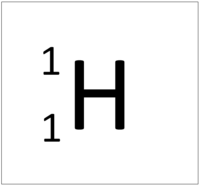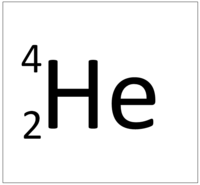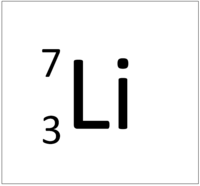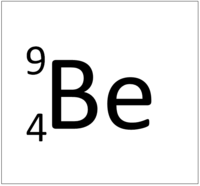Difference between revisions of "Proton"
| Line 6: | Line 6: | ||
: [[Proton]]s are a type of [[nucleon]]. | : [[Proton]]s are a type of [[nucleon]]. | ||
: [[Proton]]s have a [[Relative Atomic Charge|relative atomic charge]] of +1 and a [[Relative Atomic Mass|relative atomic mass]] of 1. | : [[Proton]]s have a [[Relative Atomic Charge|relative atomic charge]] of +1 and a [[Relative Atomic Mass|relative atomic mass]] of 1. | ||
| + | {| class="wikitable" | ||
| + | | style="height:20px; width:200px; text-align:center;" |'''Hydrogen''' | ||
| + | | style="height:20px; width:200px; text-align:center;" |'''Helium''' | ||
| + | | style="height:20px; width:200px; text-align:center;" |'''Lithium''' | ||
| + | | style="height:20px; width:200px; text-align:center;" |'''Beryllium''' | ||
| + | |- | ||
| + | |[[File:HydrogenSymbol.png|center|200px]] | ||
| + | |[[File:HeliumSymbol.png|center|200px]] | ||
| + | |[[File:LithiumSymbol.png|center|200px]] | ||
| + | |[[File:BerylliumSymbol.png|center|200px]] | ||
| + | |- | ||
| + | | style="height:20px; width:200px; text-align:left;" |This [[atom]] has an [[Atomic Number]] (Z) of 1 therefore it contains 1 [[proton]]. | ||
| + | |||
| + | | style="height:20px; width:200px; text-align:left;" |This [[atom]] has an [[Atomic Number]] (Z) of 2 therefore it contains 2 [[proton]]. | ||
| + | |||
| + | | style="height:20px; width:200px; text-align:left;" |This [[atom]] has an [[Atomic Number]] (Z) of 3 therefore it contains 3 [[proton]]. | ||
| + | |||
| + | | style="height:20px; width:200px; text-align:left;" |This [[atom]] has an [[Atomic Number]] (Z) of 4 therefore it contains 4 [[proton]]. | ||
| + | |} | ||
==Key Stage 5== | ==Key Stage 5== | ||
Revision as of 17:36, 18 July 2019
Key Stage 4
Meaning
The Proton is a positively charged particle found in the nucleus of an atom.
About Protons
- Protons are a type of nucleon.
- Protons have a relative atomic charge of +1 and a relative atomic mass of 1.
| Hydrogen | Helium | Lithium | Beryllium |
| This atom has an Atomic Number (Z) of 1 therefore it contains 1 proton. | This atom has an Atomic Number (Z) of 2 therefore it contains 2 proton. | This atom has an Atomic Number (Z) of 3 therefore it contains 3 proton. | This atom has an Atomic Number (Z) of 4 therefore it contains 4 proton. |
Key Stage 5
Meaning
A proton (p) is a baryon made from 2 up-quarks and 1 down-quark.
About Protons
- A proton is one of two baryons found in the atomic nucleus.
- Protons have a charge of 1.60x10-19 Coulombs (the elementary charge) and a mass of 1.67x10-27kg.
- A proton is the most stable hadron with a half life longer than the age of the Universe.
| Subatomic Particle | Quark-composition | Charge/e | Strangeness | Baryon Number | Lepton Number |
| \(uud\) | \(q=+1\) | \(S=0\) | \(b=+1\) | \(l=0\) | |
| \(\bar{u}\bar{u}\bar{d}\) | \(q=-1\) | \(S=0\) | \(b=-1\) | \(l=0\) |



